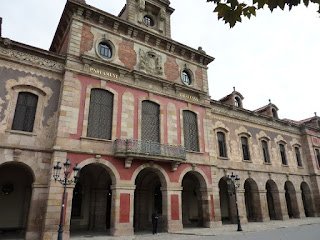Catalan Parliament
The Catalan Parliament building is located at a quiet corner of the city park (Ciutadella Park). It is off the beaten track and is not exactly a tourist hotspot, and it is therefore worth describing in this Blog. The region of Catalan, which Barcelona is part of, is run as a semi-autonomous district. The history of the Catalan Parliament, and the building, are representative of the tumulus pasts of Spain and are therefore of particular interest.
The Catalan parliament is one of the oldest parliaments in the world, dating back to the 11th century. Under the reign of James I the Conqueror the General Courts of Catalonia was formed, with a constitutional government that gradually acquired autonomy and executive powers. The War of Succession broke out in 1702, as a result of conflict of dynastic succession to the throne of Castile and Catalonia-Aragon. Catalonia made the unfortunate choice of supporting the Archduke Charles of Austria and recognized him as king, and his defeat in the war led to Philip V abolishing all Catalan public rights and institutions. Philip ordered the construction of a massive fort to control the city. Two centuries later, with the formation of the Second Spanish Republic, a provisional Catalan government was established, evolving into a self-governing body with legislative, executive, and judicial arms. Most of the citadel was demolished, except the arsenal which was rebuilt into a royal palace, then turned into an art museum, and finally in 1932 it was turned into the parliament. However the Spanish Republic was defeated by Franco’s revolt in 1939 and under his dictatorship all Catalan political institutions were dissolved again. It was not until 1980, years after Franco’s death, that election was held and a new parliament was formed.
As part of Spain's policy to keep the public informed and involved, most public buildings have open houses during the weekends. That's great for us visitors too! Here are some pictures of the parliament. It looked like we were the only tourists. There are guided tours provided, unfortunately in Spanish only.















